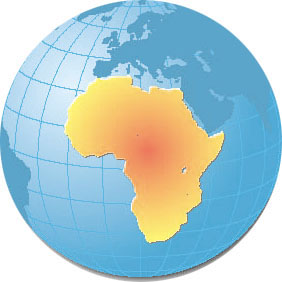
It is well acknowledged that African women are key players in the region’s agricultural sector, and that their participation is critical to achieving food security and economic well being. In many traditional agricultural enterprises, roles can be well defined along gender lines. However, most aquaculture systems are non-traditional and gender delineations less well documented.
A large percentage of both market-orientated and non-market-orientated aquaculture systems in the region rely heavily, if not exclusively, on family labour. Although this labour may be somewhat segregated along gender lines, with men at times doing construction and women marketing, aquaculture is typically a family affair. All family members contribute to pond management and harvesting, including children.
A case in point is the small-scale commercial fish farm of Mr and Mrs Awa in Yemssoa, Cameroon. Mrs Awa (photo) shares aquaculture management responsibilities equally with her husband and is the focal point for the majority of pond operations. Over the past few years, this family has developed a multi-pond complex with approximately a third of a hectare in catfish and tilapia production. Aquaculture is progressively replacing cocoa, the traditional cash crop, as the prime income earner.
Another example is Mr and Mrs Lucien Awoa, who began fish farming in 1998 with the construction of a 100 m2 pond in the small town of Komo, in the Arrondissement of Obala. Their initial intent was to produce fish to feed the family, and they were fairly content with this goal until a new project on market aquaculture came to town in 2001. Since finding that access to markets can open new opportunities for income generation, the Awoas have built three additional ponds (230, 300 and 350 m2) and increased their gross yield to 5 000-6 000 kg/ha. Aquaculture is currently earning the family some fcfa 800 000 per year, a 40 percent increase over pre-aquaculture cash income.
Family-run units are often administratively attributed to the man of the household, as customary ownership and benefits can have gender exclusiveness. Thus, census data citing women fish farmers are limited to woman-headed households and do not take into consideration the management responsibilities where women are raising fish as part of a mixed-sex family entity.
Begun in March 2003, an FAO Technical Cooperation Programme project "Strengthening the Organizational Capacity of Fish Farmer Groups" (TCP/GHA/2904) is reviewing gender roles in aquaculture in Ghana. Through contributions from FAO’s Gender and Development Service (SDWW), this project will determine how paying more attention to gender issues of can strengthen group coherence. It will also address gender as it relates to marketing and communications channels.
Aquaculture development in the Africa Region has gone through a series of highs and lows over the past four decades. It has alternately been cited as a panacea for fish supply or accused of having grossly substandard performance and being a waste of public resources. These cycles lead to a waxing and waning of attention to aquaculture. Often the progress made during a "high" period was completely undone during a "low" period. In the aggregate, the tangible results are few and the subsector remains noticeably under-productive.
Many of the mediocre results obtained to date can be attributed, in hindsight, to inappropriate approaches to aquaculture development. In the 1970s and 1980s, government was seen as the engine driving aquaculture. Government stations and hatcheries were perceived as indispensable hubs of extension support and input (seed and feed) supply. These donor-driven efforts produced scores of aquaculture extensionists who scoured the countryside on project-provided transport promoting fish farming – often expounding production "packages" that were totally inappropriate to local conditions and needs.
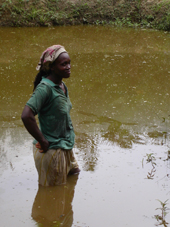
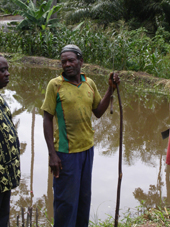
In the 1990s, many African countries faced serious political-economic challenges, and downsizing became a common remedy to economic shortfalls. Structural adjustment programmes reshaped the agricultural sector, and many national aquaculture programmes nearly vanished in the process. Dedicated government aquaculture extension services and the related myriad of hatcheries and stations became too expensive to maintain and thus, many fish farmers found themselves with no external support and either abandoned aquaculture or found ways to "go it alone".
Cameroon has an aquaculture history typical of the region and has suffered many of the political-economic debacles that have visited much of the African Continent. In addition to the prevailing shift in government role from that of a producer to that of a facilitator, Cameroon has experienced many of the other common phenomena, including urbanization, resource deterioration, balance of trade deficit and unemployment. Within this evolving economic environment, aquaculture is again identified as a subsector with significant under-utilized potential to tackle these challenges. Yet, acknowledging the irregular path of aquaculture development, government requested assistance in developing a strategic framework to guide the future expansion of the subsector.
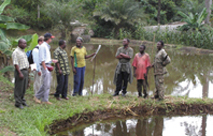
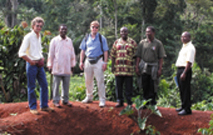

In response to this request, an interagency aquaculture team was assembled (see photo) representing the technical and research ministries, as well as international research and development organizations. This team spent ten days meeting with stakeholders and elaborating the structure of the strategic framework. This framework is intended as a scaffold upon which a thorough development strategy can be built. It identifies the key elements of the strategy and describes how each should be addressed. Major points include:
With support from the FAO Technical Cooperation Programme through TCP/GUI/0066, the Government of Guinea has developed pilot aquaculture activities in the Forest Zone. This area is one of the few parts of the country, and the region as a whole, where there has not been a relatively long history of aquaculture promotion. Within the context of the Special Programme for Food Security (SPFS), the aim of this project is to establish a core of farmers who are growing fish in an economically profitable and socially sustainable way with the intent of becoming self-sufficient aquaculturists, independent of long-term government support.
Project activities focused on three districts: Seredou, Yomou and Lola. In each district, the objective was to establish a group of ten fish farmers and to provide them with appropriate training in pond construction and management such that average yields at the end of the project would be 1 500 kg/ha/yr. Farmers in each district received close technical backing from an Aquaculture Assistant, a resident from the district who received specialized training from the project and served in the role of extensionist. Assistants filled the gap created by the lack of a government aquaculture outreach programme. However, from the onset, their positions were considered as catalytic – ending once the prerequisite core of aquaculturists was functioning as a coherent and independent farmer group.
By the end of the project, 31 farmers in the three-district area were raising fish in 36 ponds with an average yield of 3 400 kg/ha/yr. The ponds were constructed by the farmers themselves, relying solely on locally available inputs and family resources. An evaluation at the completion of TCP support concluded that:
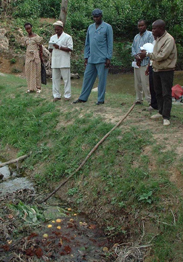
Nigeria has become one of the largest importers of fish in the developing world, importing some 600 000 metric tonnes (mt) annually. To solve the country’s high demand for fish, Nigerians must turn to their under-utilized inland waters for improved fish production and aquaculture. There is a growing awareness of aquaculture in Nigeria, with more than 100 private commercial fish farms currently in production. In addition to these producers, government efforts have included major investment in the infrastructure of some 40 public farms and hatcheries, but most of these are not operating at present. Aquaculture expansion, moreover, has been a slow process, as private-sector fish farmers have faced major constraints, including lack of seed and quality feed.
As in much of Africa, the most commonly cultured species include catfish (Clarias garipinus, the imported C. lazera, and Heterobranchus sp.), tilapia and carp. Many fish farms focus on catfish, as they can have a market value of two to three times that of tilapia. Some farms located in cooler areas are raising carp, as a variety of carp have been introduced in Nigeria, including bighead, silver, grass and common carps.
Fish feeds have been cited as a major constraint to aquaculture development. The animal feed industry in Nigeria produces some 3.5 million mt of animal feeds each year, with most of this going for chicken production. As a result, chicken feeds cost less than half the price of locally produced aquafeeds. Because of the sometimes recurrent feed supply problem, several of the intensive catfish producers import extruded floating feeds from Europe. Although these imported feeds cost more than twice the price of local aquafeeds, they can be more reliable in terms of quality and availability.
Although fish farms presently cover an estimated 60 000 ha of the country and produce some 25 000 to 30 000 mt of fish per year, this equals less than 0.5 mt/ha/yr. If aquaculture is to fulfil its expectations, yields must significantly increase. While some existing fish farms produce their own feeds, and the feed industry reports supplying some 25 000 mt of fish feed per year, feed quality and availability remain critical issues for farmers targeting higher yields. When combined with problematic seed supply, the overall input delivery system must be rehabilitated if aquaculture is to make a significant contribution to the Nigerian marketplace.
In part, this rehabilitation is to be accomplished through the "Aquaculture and Inland Fisheries Project" that is currently being launched. This $6.9 million project is funded by the Nigerian Government and is part of the Special Programme for Food Security. This important intervention seeks to assist 50 private fish farms and hatcheries to increase their capacity for improved management and greater production. Alleviating the major constraints of availability of inputs, including fish seed and quality fish feeds, is also among the project’s objectives. Additionally, the project will conduct stock assessments for up to 43 small to medium-size lakes and reservoirs in the country for enhancements, including the possible stocking of fish for increased catch.